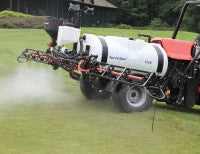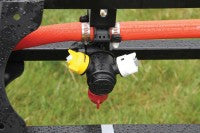The Sustainable Use Directive:
 "Those currently applying herbicides under Grandfather Rights will need to have gained certification by 26th November 2015"
"Those currently applying herbicides under Grandfather Rights will need to have gained certification by 26th November 2015"
So, the much lauded Sustainable Use Directive (SUD) is finally here and details of the Action Plan have been released. Overall, the SUD appears to be manifestly light in touch with few of the powers and constraints originally hoped for, or feared, depending on your viewpoint.
Whilst wishing for increased regulation may seem like turkeys voting for Christmas, it "worked" for agriculture, with responsible pesticide usage being essential to produce a saleable crop, a driver very much led by Farm Assurance Schemes. Without a tangible end product going onto supermarket shelves or regulatory intervention, there is a danger that, in this era of austerity and tight fiscal policy, the quick fix may win out over best practice.
With this in mind the Amenity Forum, which represents the interests of the sector with relation to pesticide use, are running a campaign to drive up standards across the industry.
Professor John Moverley, independent chairman of the Forum, launched the campaign at Saltex with a presentation on 'Promoting Best Practice & Standards in the Amenity Sector - critical issues and challenges facing the sector'. The challenges to successful implementation include the current varying standards in professionalism and knowledge across the industry, the scale of the sector, major client money pressures, water and limited products.
 Action Plan Highlights - what is needed to comply with SUD and how do we deliver?
Action Plan Highlights - what is needed to comply with SUD and how do we deliver?
On the face of it, the changes seem fairly minor. Professional companies with accreditations to existing Assurance Schemes have little to fear, and it is unlikely to change the way larger organisations do business.
However, there is a need to lift standards to a base level across the board, improve training and encourage buy-in to CPD registers, adopt more integrated measures and enhanced auditing aiming for continual improvement. A number of key points will impact on those working under Grandfather Rights, and the smaller organisations who perhaps rely on handed down knowledge rather than certification.
Key changes include an increased obligation to minimise the use of pesticides and give preference to certain types of products (those classified as least damaging to the aquatic environment). This may include reducing rates and frequencies of application, and the inclusion of other technologies or cultural controls, such as burning, hot foam or increased use of road sweepers.
The other alternative, which may be a controversial one for many turfcare professionals, is that we learn to live with higher tolerance levels for weeds, pests and diseases, although this can bring its own problems. The drive to minimise use is aimed not only at those applying the pesticide but also those who cause or  permit pesticides to be used; the managers, buyers, sellers, local authorities, clubs, the list goes on. This places an obligation on the professional end user to make sure that their client is informed of best practice. There is some serious scope here to build strong relationships with clients and land users, resulting in a more cohesive approach to landscape management.
permit pesticides to be used; the managers, buyers, sellers, local authorities, clubs, the list goes on. This places an obligation on the professional end user to make sure that their client is informed of best practice. There is some serious scope here to build strong relationships with clients and land users, resulting in a more cohesive approach to landscape management.
We must demonstrate that every precaution is being taken to prevent water pollution; this can be achieved through accurate record keeping, including calibration and application records. Environmental risk assessments should identify all features where water could be polluted, including areas of standing water, flooding, drains, water courses and weather conditions. In addition, the steps taken to prevent water pollution should also be documented.
It is important to remember that, with the new legislation, there has been a shift in perception from risk to hazard - rather than assessing the risk, we need to be minimising exposure to the hazard, in this case, the pesticide.
In the same vein, pesticide users must also demonstrate that sensitive areas have been considered and steps taken to minimise any impacts. Again, this should all be documented on an Environmental Risk Assessment.
There will be some tightening of supply and sale. From November 2015, those buying plant protection products for professional use must hold a Certificate of Competence in the safe use of pesticides, or ensure, if they are not applying it themselves that it is applied by a suitably certified individual; this will remain the current NPTC Certification. Those currently applying herbicides under Grandfather Rights will need to have gained certification by 26th November 2015.
Users and distributors must take reasonable precautions to ensure stored products, remnants, washings and packaging are all handled and disposed of in a way that does not pose harm to human health. Again, this is back to best practice, record keeping and compliance with the current code of practice; only mix enough pesticide for the task, ensure dose rates are not exceeded and rinsings can be disposed of over areas already sprayed.
 From 2016, application equipment (excluding knapsacks and hand held applicators) must be tested, calibrated and checked on a regular basis.
From 2016, application equipment (excluding knapsacks and hand held applicators) must be tested, calibrated and checked on a regular basis.
CPD (Continual Professional Development) is likely to come to the fore as a result of SUD, it is a simple way to demonstrate best practice. Too many sprayer operators pass their Pesticide Application qualifications, as part of an apprentice programme or as a trainee, and never do any further training. One of the aims of City & Guilds NPTC and the Amenity Forum is to encourage continual improvement and raise standards across the board by CPD.
The newly launched National Amenity Sprayer Operator Register (NAsOR) is set to be the industry standard for demonstrating CPD. The scheme has been launched to run as a sister scheme to NRoSO, which has been widely adopted in agriculture. In order to maintain CPD through NAsOR, the operator must collect 30 CPD points over a three year period, which can be from a number of sources such as publications and specialist update training. Further information on NAsOR can be found at www.nasor.org.uk
If pesticide application is not a day in day out activity, there is a strong case for using a competent contractor rather than tying up your most precious resource, your staff, in extra training and CPD for a spraying activity they may only carry out a couple of times a year. Using a competent contractor may seem more expensive than carrying out work in-house, however the initial outlay of using a specialist may reap benefits in a reduction in time taken to control the problem, especially for problems such as invasive weeds.
Contractors tend to be specialists in their area, they do the job day in, day out, so they should be efficient, knowledgeable and accurate. Many also offer warranties and call backs if things do not go quite the way they were planned.
What to consider when calling in the contractors?
Look for specialists - do they have the equipment for the task and a proven track record? Ask to see maintenance records and service schedules. A contractor will provide you with advice on how to proceed, a plan of action, including timescales and up to date Risk Assessments, Method Statements and COSHH assessments. Keep an open mind. Your contractor may be able to advise you on a more effective method of control and be up to date with current technology and best practice.
Is your contractor accredited? There are a number of contractor assurance schemes out there, many are aimed at construction and utilities, however, they all require the contractor to demonstrate competence in the activities they are accredited for, and either require annual renewal or audit to remain accredited.
In addition to these broad brush contractor schemes, such as Safe Contractor and Achilles UVDB, there are specialist amenity assurance schemes such as BASIS, BACCS and Amenity Assured. These are the benchmark for best practice in the industry and, with time and the right encouragement, should be the default requirement for all local authorities and large organisations tendering for contracts involving pesticides.
Don't be afraid to ask for certification for staff and references from previous satisfied customers. Most essentially, keep a copy of your environmental risk assessment, spray records, calibration records and sprayer MOT, whether you do the work in-house or use a contractor. These will prove invaluable should any issues arise and you need to prove that best practice was adhered to.
It is looking likely that water protection will be the driver for change in the Amenity Sector. Pesticide levels above 0.1µg/l may compromise ground water supplies, and water companies must maintain levels below this. 80% of all drinking water protected areas register some level of metaldehyde contamination, and pesticides are an issue in around 60% of 'at risk' areas.
The drive to reduce pesticide levels in water could have far reaching consequences for the timing and amount of pesticides that can be used, and lead to increased use of alternative technologies.
Recent research headed up by East Malling Research has shown that it is possible to get adequate amenity weed control through mechanical means. They have taken ten trial areas in the Thanet region of East Kent and carried out pavement and highway weed control through chemical, integrated chemical and mechanical or solely mechanical means to ascertain the level of control and monitor glyphosate levels in water courses as a result of the differing approaches.
Thanet's groundwater is very vulnerable to pollution due to thin soils overlying porous rock. They also have a high reliance on groundwater to prop up their drinking water supplies. The research showed spikes in glyphosate run-off into drains, spiked at the first rainfall event, but was higher than on the mechanical trial sites even after three or four rainfall events. More information on this trial can be found at http://www.eastmallingresearch.com/Weeds.
 The core principals of SUD are a need for all users to understand and follow best practice, to invest in training and to implement a programme of Continual Professional Development (CPD). With limited enforcement now, more than ever, it is essential that users of pesticides, and particularly those employing contractors or tendering contracts for pesticide application, ensure that they comply with best practice and promote a tendering process which emphasises the value placed on getting the job done right, and not just getting the job done.
The core principals of SUD are a need for all users to understand and follow best practice, to invest in training and to implement a programme of Continual Professional Development (CPD). With limited enforcement now, more than ever, it is essential that users of pesticides, and particularly those employing contractors or tendering contracts for pesticide application, ensure that they comply with best practice and promote a tendering process which emphasises the value placed on getting the job done right, and not just getting the job done.
Failure to take on board the recommendations of the Voluntary Initiative and the SUD Action Plan could have catastrophic consequences for the already limited selection of pesticides we are able to use in the Amenity sector. Whilst cultural control is a must in any serious management plan, and green technologies are much improved on previous prototypes, they have their limitations and would struggle to fill the gap should a blanket ban be imposed.
Additionally, the cost to employ these technologies is far higher than conventional weed control, and some research suggests the payment in terms of carbon emissions is far higher than the CO2 footprint of conventional spraying.
Effective self regulation and compliance with the Voluntary Initiative will prevent enforced regulation, which could be much more painful than the current raft of measures.
Further details of the SUD Action Plan and best practice can be found at www.amenityforum.co.uk and www.voluntaryinitiative.org.uk
Article written by Victoria Wall BSc Hons MBPR, SHEQ Compliance Manager, Hortech Ltd
